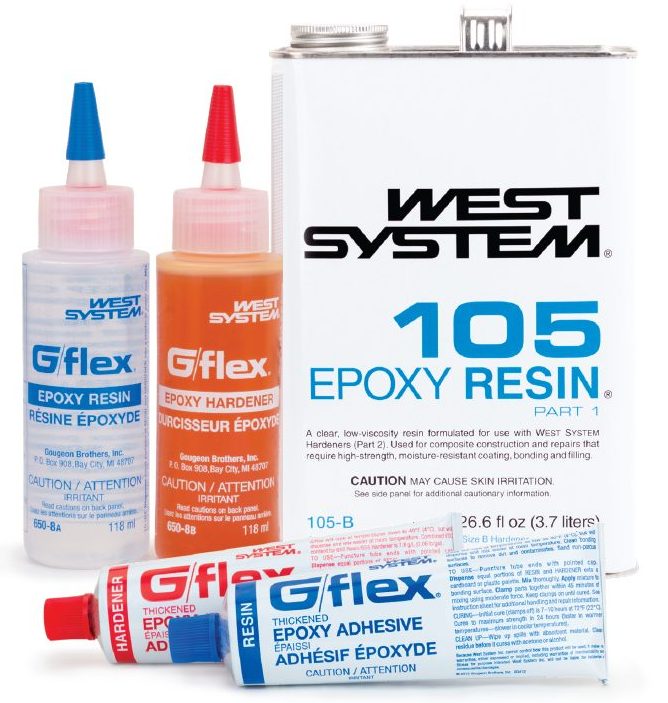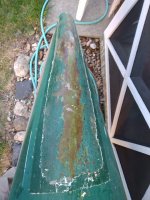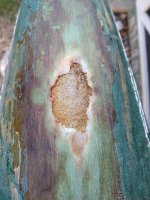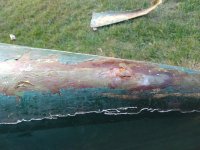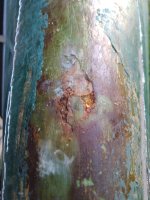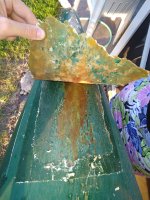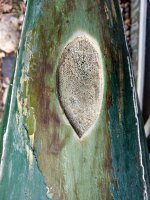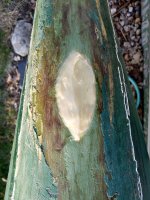Hello there!
My hand is being forced on a repair project that I’ve been keeping an eye on for the last year or so.
I think I have a plan but it seems prudent to get some more advice before getting any further into it.
The craft:
17’ Royalex Mohawk.
The situation:
This is definitely an older canoe. It lives with me on a long term/permanent loan arrangement. When I took ownership of it, it came with DIY skid plates. After a few Wisconsin winters though, the one on the bow has started peeling off. The canoe itself seems fine underneath. Regardless, it’s time to fix it.
My plan:
At this point, I wish to remove what I can of the existing skid plate and then to apply a new one. My intention is to follow the steps outlined in this thread:
So far I have done some exploratory sanding/rasping to see what I’m working with. The skid plate is not terribly difficult to sand/rasp back. I’m not sure how much of the existing plate I will need to remove before I can apply a new layer. My thought is that once it’s faired out I should be set. However, I fully acknowledge that I haven’t done this before and might be on the wrong track.
The reasoning:
I’ve read through a fair number of threads about pros/cons of skid plates. I can see both sides of the topic. For my uses though, bow reinforcement is non-negotiable. This canoe is used exclusively for fishing and the majority of that is done in smaller rivers which have their fair share of incredibly shallow gravel bars. Obviously an effort is made to avoid them, but given the quantity it’s a matter of when—not if—I’ll end up scraping. Not the prettiest outlook, but this is why I’m interested in taking precautionary measures to protect it.
Outcome:
Ideally, I would like for the canoe to be a little more durable then when I started. It's been good to me so far and I'd like to do what I can to keep it floating and functional. I haven't done anything like this previously. My expectations for aesthetic appearance are low. As long as it's at least on par with what's already on their I'll be satisfied.
On a final note, I started sanding before I took any photos. There was significantly more paint before I started messing with it.
My hand is being forced on a repair project that I’ve been keeping an eye on for the last year or so.
I think I have a plan but it seems prudent to get some more advice before getting any further into it.
The craft:
17’ Royalex Mohawk.
The situation:
This is definitely an older canoe. It lives with me on a long term/permanent loan arrangement. When I took ownership of it, it came with DIY skid plates. After a few Wisconsin winters though, the one on the bow has started peeling off. The canoe itself seems fine underneath. Regardless, it’s time to fix it.
My plan:
At this point, I wish to remove what I can of the existing skid plate and then to apply a new one. My intention is to follow the steps outlined in this thread:
More Skid Plate Repairs and Retrofits
The skid plates on my favorite RX big boy tripper, the soloized Penobscot 16, are kevlar felt with OT urethane resin, still firm and flush-ish to the hull. That was one of the last kevlar felt skid plate kits I ever installed; even done properly, smoothed down with beveled edges, I curse the day...
www.canoetripping.net
So far I have done some exploratory sanding/rasping to see what I’m working with. The skid plate is not terribly difficult to sand/rasp back. I’m not sure how much of the existing plate I will need to remove before I can apply a new layer. My thought is that once it’s faired out I should be set. However, I fully acknowledge that I haven’t done this before and might be on the wrong track.
The reasoning:
I’ve read through a fair number of threads about pros/cons of skid plates. I can see both sides of the topic. For my uses though, bow reinforcement is non-negotiable. This canoe is used exclusively for fishing and the majority of that is done in smaller rivers which have their fair share of incredibly shallow gravel bars. Obviously an effort is made to avoid them, but given the quantity it’s a matter of when—not if—I’ll end up scraping. Not the prettiest outlook, but this is why I’m interested in taking precautionary measures to protect it.
Outcome:
Ideally, I would like for the canoe to be a little more durable then when I started. It's been good to me so far and I'd like to do what I can to keep it floating and functional. I haven't done anything like this previously. My expectations for aesthetic appearance are low. As long as it's at least on par with what's already on their I'll be satisfied.
On a final note, I started sanding before I took any photos. There was significantly more paint before I started messing with it.
Attachments
-
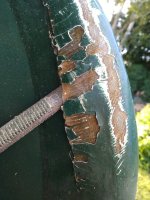 IMG_20220712_192530697.jpg155.6 KB · Views: 40
IMG_20220712_192530697.jpg155.6 KB · Views: 40 -
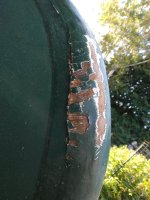 IMG_20220712_192523845.jpg139.7 KB · Views: 39
IMG_20220712_192523845.jpg139.7 KB · Views: 39 -
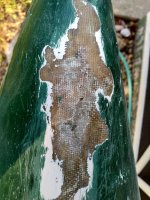 IMG_20220712_192513193_HDR.jpg199.2 KB · Views: 40
IMG_20220712_192513193_HDR.jpg199.2 KB · Views: 40 -
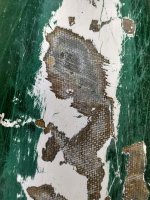 IMG_20220712_192507526_HDR.jpg230.4 KB · Views: 40
IMG_20220712_192507526_HDR.jpg230.4 KB · Views: 40 -
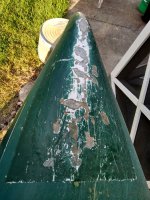 IMG_20220712_192455912_HDR.jpg205.7 KB · Views: 40
IMG_20220712_192455912_HDR.jpg205.7 KB · Views: 40 -
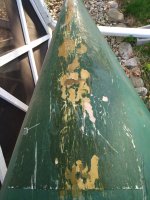 IMG_20220712_192427077.jpg159.5 KB · Views: 38
IMG_20220712_192427077.jpg159.5 KB · Views: 38 -
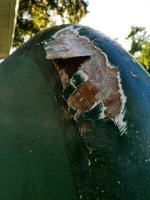 IMG_20220712_192909713_HDR.jpg117.8 KB · Views: 38
IMG_20220712_192909713_HDR.jpg117.8 KB · Views: 38 -
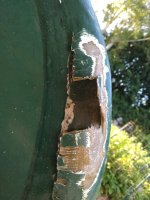 IMG_20220712_192903159.jpg128.8 KB · Views: 39
IMG_20220712_192903159.jpg128.8 KB · Views: 39

